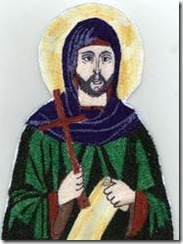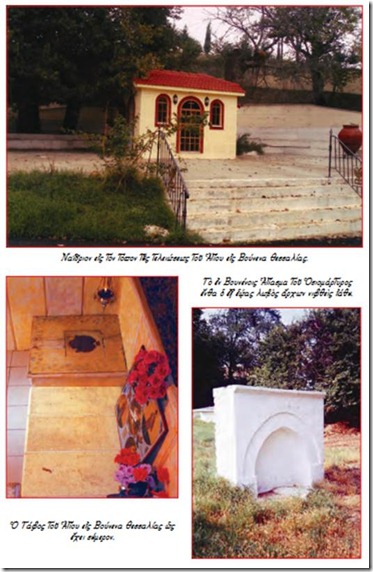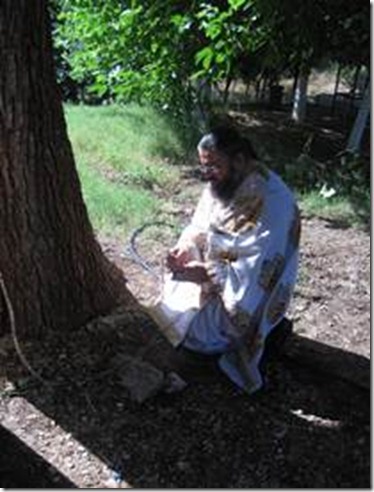SAINT NICHOLAS THE NEW MONK – MARTYR OF VOUNENA
By Archimandrite Nectarios N. Pettas Phd
Athens, July 2011
During my childhood my father, who was a priest, would tell me about the miracles St Nicholas the New Monk whose name’s day is celebrated on the 9th May. Because of various obligations in Athens at that time of year wasn’t able to go to Vounena. However, I realized that in order for me to believe what I had heard I needed to see things first hand for myself.
Consequently, I decided to go to St. Nicholaos at Vouvena on 23 May 2011 and arrived at 7am in the morning with a group of spiritual people. Following the Divine Liturgy and the artoklasia[1] we slowly left the church and headed towards the elm grove in which the saint was martyred. Here we kneeled in front of the trees and prayed a supplicatory canon for ourselves and those known to us. While we were chanting “It is truly meet” – Glory to God! Suddenly a porphyry coloured liquid that looked like blood started flowing from some of the trees. We started collecting this very carefully in containers because of its miraculous power which we had heard about from many people who had been cured, specifically of dermatological problems and cancer. After receiving this priceless gift we gave thanks to the saint for two reasons. Firstly, for the inexplicable miracle of the red liquid that flowed from the trees Secondly, for this liquid that only flows from these trees on St. Nicholas’ name’s day. However, for us to bear witness, it appeared specifically on the day we were there.
St. Nicholas, the New Monk-Martyr was probably born in Asia Minor. From his childhood, he was distinguished by his love and strong faith and trust in God. His virtue and valour were also very distinctive character traits. Consequently, his parents decided to encourage him professionally to follow a military career, so they enlisted him in the Roman army. His reputation quickly travelled beyond the narrow limits of his home spreading to the Imperial City of Constantinople. At this time, the Emperor Leo VI, The Wise (886-912 AD) who had already gathered information about Nicholas called him to his side so that he could judge his character for himself. After talking with him for a short period his gifts were evident and he was also impressed by his physical and spiritual strengths. As a result Emperor Leo decided to confer on him the title of Duke and he then appointed him as leader in the imperial military forces. He sent him to Larissa, where he was to guard and defend this capital city of Thessaly. Nicholas assumed his duties with zeal and taught his soldiers not only the art of war but also of the spiritual life. Over time he managed to gain their love and trust.
When the Arabs descended on Thessaly armed to attack, barbarian raids, devastation and death were rampant. Nicholas with only meagre forces tried to stop the enemy. However, the huge enemy forces easily conquered, taking part in a general massacre and pillage of the area. Many residents fled the city and the region and they sought refuge in mountainous areas of Tynarvo just outside Larissa. Nicholas with his soldiers retreated to the forest on Mount Vounena where there were many ascetics living in sketes in the steep mountains. He settled near them, taking part in their spiritual practice and prayer. Nicholas had his soldiers with him who also began to live a spiritual and holy life like the monks.
One evening, while the saint was praying, an angel of the Lord appeared to him and announced his forthcoming death and that of the other monks saying: “Come, athletes of Christ, prepare yourselves for martyrdom”. This was followed by the enemies arresting them and they were then tortured by the crowd. They urged them to deny their faith. However, they remained unshaken in the faith of their fathers demonstrated and testified to by their deaths. Consequently, their names were engraved in gold in the book of heaven. From the names which were saved we know the following: Akindinos, Armodios, Gregory, Demetrios, Evodios, Theodore, John, Michael, Pagkratios, Pantoleon, Christopher and Emilianos.
In the biography of St. Nicholas are also noted two names of women Martyrs, Irene and Pelagia which are included with the names of soldiers and Martyrs. Evidently they were two Christian heroines, martyrs for the love of Christ. They belonged to the civilian population of the city of Larissa and had taken refuge in the mountains of Tyrnavos.
Following the massacre the blessed Nicholas, distinguished for bravery, managed to escape, to the fury of the enemy. Travelling through parts of Larissa and Tyrnavos he arrived in inner Thessaly, in the area of Karditsa, where the village of Vounena is situated. There he found a suitable place for ascetic practice and a cave for shelter, which was covered by elm trees. He continued to live an ascetic life, which had begun near the ascetics of Tyrnavos. He relinquished any worldly desires and thwarted off any demonic attack with the grace of God dwelling within him.
However, the barbarian invaders discovered the athlete of Christ, Nicholas. They arrested him and pressured him with promises and persuasion to deny his faith. However, all of this he bravely resisted. So they began torturing him and finally pierced his heart with their spears. God was moved because Nicholas endured such tortures in His name. Eventually, the invaders decapitated the Righteous- Martyr Nicholas who was finally crowned with the amaranthine wreath of glory entering the joy of the Lord.
The Bishop of Larissa, Philip, participated in the procession to the town of Tyrnavos carrying the relics of the Martyrs. These holy relics had been discovered earlier by Duke Effimianos of Thessaloniki.
Effimianos was once seriously ill from the terrible disease of leprosy. He sought treatment from many physicians, but all in vain. Then he began to invoke the various saints thereby hoping to receive charity and the mercy of God. Furthermore, he offered money to widows, orphans and the poor and begged God to give him mercy to return to good health. Whilst he was praying one day he saw a vision of the patron saint of Thessaloniki, Saint Demetrios who told him that he wouldn’t be healed in that city and that he needed to go to Thessaly. There the patron Saint of Larissa was Achilleios. Effimianos had heard a lot about the miracles of these two patron saints. So having arrived in Larissa he went to pray in front of the relics of St. Achilleios when God advised him to go to the mountains of Vounena.
The vision Effimianos received directed him to find the sacred relics of the Righteous-martyr Nicholas. After this he was to wash at a spring close by and to have faith in finding the right cure for his illness. Happy with these promising words he left for Vounena where he found the holy relics of St. Nicholas after which he bathed in the spring. Within a short time he was cured of his leprosy. Full of joy and gratitude for the cure which was given to him by the Righteous-Martyr of Christ, he built a small church and it was there that he entombed the holy relics.
Today many relics are saved in the Peloponnese whilst his head is found at the Monastery of St Nicholas on Andros. Many churches all over Greece are given his name whilst they are often adorned with frescoes depicting his image.
[1] A short service blessing special sweet bread, wine and oil.




